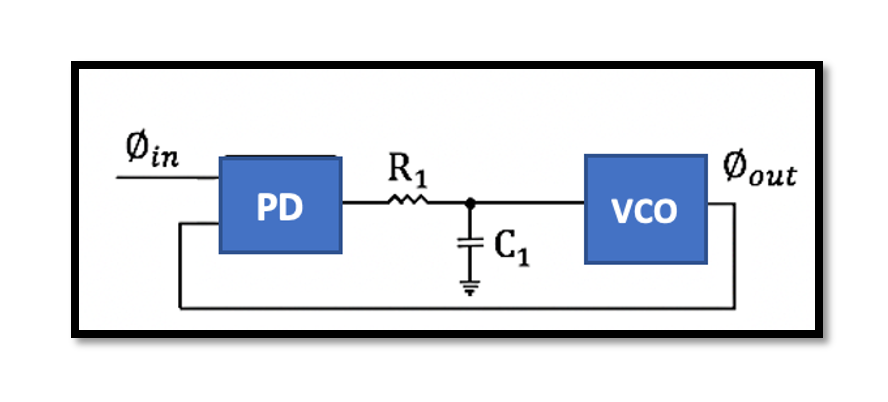
Understanding the Transfer Function of a Phase-Locked Loop (PLL)
A Phase-Locked Loop (PLL) is an essential component in various communication systems, offering the ability to synchronize an output signal’s phase and frequency with a reference input signal. This synchronization is crucial for applications such as clock generation, frequency synthesis, and signal demodulation. In this blog, we will delve into the transfer function of a PLL, exploring its behavior under different conditions and explaining why the output phase tracks the input phase closely only for slow phase variations.
Open-Loop Transfer Function

The open-loop transfer function 𝐻𝑜𝑝𝑒𝑛(𝑠)of a PLL is given by the product of the transfer functions of the individual components:

Here, 𝐾𝑃𝐷 is the gain of the phase detector, 𝑅1𝐶1 represents the low-pass filter parameters, and 𝐾𝑉𝐶𝑂 is the gain of the voltage-controlled oscillator.
Closed-Loop Transfer Function
To understand how the PLL tracks the input phase, we look at the closed-loop transfer function 𝐻𝑐𝑙𝑜𝑠𝑒𝑑(𝑠):

Interpretation in Control Theory
In control theory terms, the closed-loop transfer function can be expressed in a standard form:

Why the Output Phase Tracks the Input Phase Closely for Slow Variations
The key insight is that the PLL’s ability to track the input phase depends on the bandwidth of the loop filter. For slow phase variations (low-frequency components), the low-pass filter allows the phase detector’s output to pass through, enabling the VCO to adjust the output phase accurately.
However, for fast phase variations (high-frequency components), the low-pass filter attenuates these signals, reducing the VCO’s ability to respond quickly. Consequently, the PLL can only track the input phase closely when the variations are slow, as the loop filter can process these changes without significant attenuation.
Take our entry level course (Below) for free using coupon code RAHRF101BLOG
RF Fundamentals, Basic Concepts and Components – RAHRF101
For limited time take an additional 10% off of all our courses using coupon code RFCERT10
Rahsoft RF Certificate and courses
Theoretical Insights and Design Considerations
From a theoretical standpoint, the design of a PLL involves carefully selecting the parameters of its components to achieve the desired performance. The phase detector, low-pass filter, and VCO each play a crucial role in determining the PLL’s overall behavior. The phase detector’s gain 𝐾𝑃𝐷, the low-pass filter’s time constant 𝑅1𝐶1, and the VCO’s gain 𝐾𝑉𝐶𝑂must be chosen to ensure that the PLL can lock onto the input signal and track phase variations accurately.
Designers must also consider the trade-offs between loop bandwidth and noise performance. A wider loop bandwidth allows the PLL to respond more quickly to changes in the input phase, but it also makes the system more susceptible to high-frequency noise. Conversely, a narrower bandwidth improves noise performance but limits the PLL’s ability to track fast phase variations. Balancing these factors is key to designing an effective PLL.
Conclusion
The transfer function of a PLL provides valuable insight into its behavior and limitations. By analyzing both the open-loop and closed-loop transfer functions, we can understand why a PLL tracks the input phase closely only for slow variations. This understanding is crucial for designing PLLs that meet the requirements of various applications in communication systems. Understanding the detailed behavior of PLLs and their transfer functions allows engineers to design more robust and efficient systems, ensuring accurate phase synchronization in various technological applications.

Learn more about this topic by taking the complete course ‘Phase Lock Loop System Design Theory and Principles RAHRF469’. Watch the course videos for more detailed understanding. Also checkout other courses on RF system and IC design on https://rahsoft.com/courses/. Rahsoft also provides a certificate on Radio Frequency. All the courses offer step by step approach.



